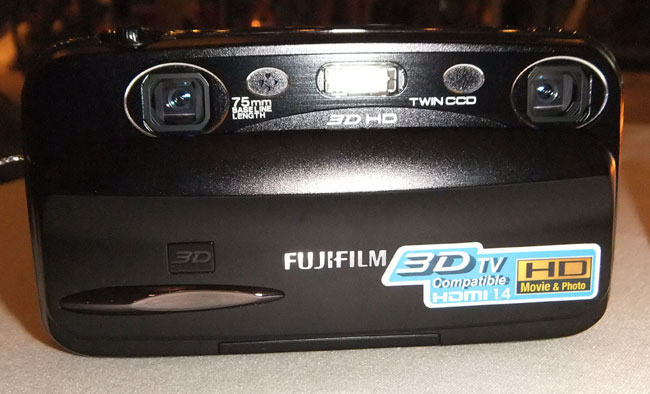
Considering that around 2 million 3D HDTVS are expected to be sold this year, 3D may no longer be a gimmick. Last month, Sony announced its own 3D still cameras, the DSC-TX9 $400, DSC-T99 $250, both single lens models. Both of these, plus the Fuji W3 ($500), will go on sale early next month.
Spec-wise, the W3 has twin 10 MP CCD sensors under a horizontal sliding lens cover that turns the camera on and off, a 3x optical zoom (35-105mm), a 3.5-inch 16:9 auto stereoscopic LCD (which means you can see 3D images without glasses while framing and in playback), and an HDMI 1.4 output jack to connect the W3 to a 3D HDTV. You can shoot both 2D and 3D photos as well as 2D and 3D 720p AVI movies. Even built with solid steel, the W3 is surprisingly light – just 8.5 ounces.
3D adds a level of complication to shooting – there’s a dedicated 3D button and “3D” or “2D” appears in a big red onscreen label to make sure you know which mode you’re in. There’s a manual parallax control to adjust the overlaid twin views in the viewfinder to compensate for individual human focusing idiosyncrasies.
In addition to regular auto mode, you also get aperture priority shooting as well as fully manual and 13 program modes.
You’ll have to get used to slightly different image capture rules. To make sure you get good depth front-to-back, Fuji suggests you stand at least six feet away from the subject closest to the camera, and no shooting in portrait mode for reasons that were unexplained. When shooting 3D video, make sure you pan the camera sl-o-o-o-wly so the viewers eyes have time to adjust to depth perception – if you’ve watched any sports in 3D, you know quick moving objects can give you an eye or headache. If you’re shooting groups of folks, it’ll be best to stagger them to really get the depth effect, even if their initial instinct is to stand side-by-side. As I shot samples, I tried to make sure there was depth in the subject, which means different angles and framing – you’ll do more shooting from a three-quarter view, for instance – than you’d consider for 2D.
The W3 has several auto and manual shooting modes; the most interesting being simultaneous close-up/widescreen images. Since the W3 has two independent lenses, you can capture both a widescreen image and a simultaneous close-up of the same subject, with the widescreen shot framed in a small picture-in-picture. You can also shoot simultaneous images with different color tonality (such as one in color and one in black and white), or two simultaneous shots with different ISO settings – sort of simultaneous bracketing.
Images and video can be viewed on any 3D HDTV but, like any 3D image, there is a narrow sweet spot. Shots shot in 3D viewed on a 2D display look as if they were shot with a standard 2D camera, but 3D video seemed a little fuzzy and grainy, possibly because of the somber-lit interior of the museum (Ben Stiller’s antics in the museum were far brighter illuminated). Fuji also has a U.S.-based 3D still picture processing center; 5 x 7 3D prints cost $7 each.
So, is the W3 worth $500 as an alternative to a regular 2D digital camera? We’ll know more when we have a more extensive hands on, but for the time being, playing with this non-gimmicky 3D camera was definitely cool.
Here are some samples:







